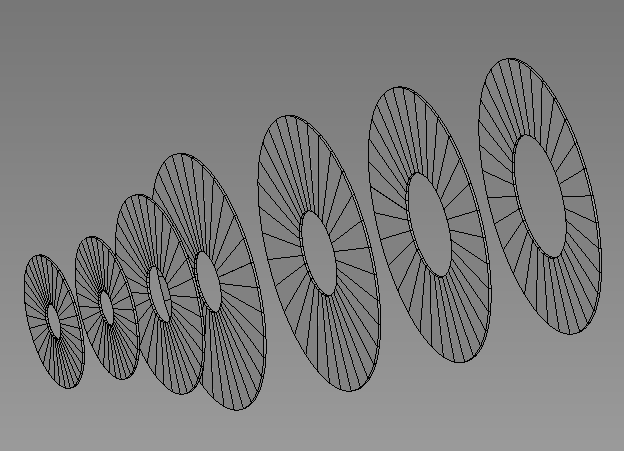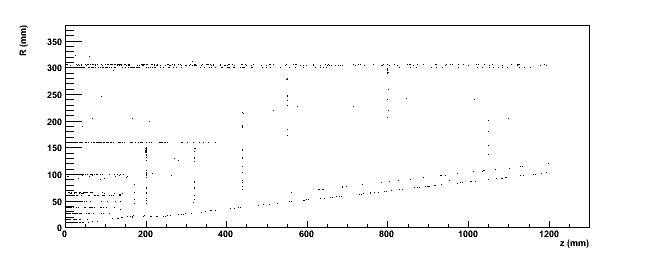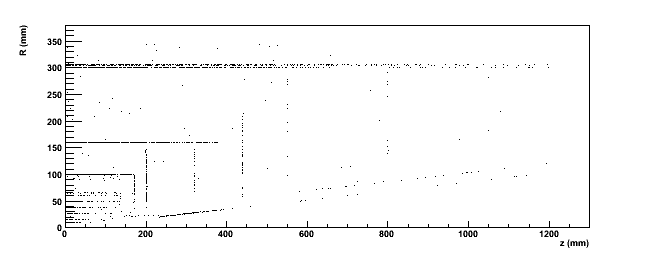|
 Particle Flow. Particle Flow.
The impact of the essential tracker parameters on the tracking performance has been discussed in previous sections. Here, the scope of the discussion is broadened to the overall detector performance. Central to the philosophy of most ILC detectors is the concept of particle flow. In this paradigm the tracker plays an important role in the jet energy determination: at the heart of the algorithm is the tracker's excellent momentum measurement for charged particles. In this section, the impact of tracker parameters - particularly the material budget of the forward tracker - on the particle flow performance is discussed.
The impact of the tracker material on particle flow
Studies of the performance of particle flow algorithms of the ILC detector concepts with "cheated" tracks [Mark Thomson] indicate that confusion is the paradigm's greatest enemy. In energetic, highly collimated jets, the incorrect association of reconstructed tracks and calorimeter energy deposits is likely to limit the jet energy resolution. One source of confusion comes from interactions in the tracker material.
In the figure below, interactions of particles with detector material are used to map out the inner and forward tracker geometry. In the uppermost figure the vertex of pion nuclear interactions are represented. The middle figure shows photons converting to e+ e-. In the final figure the position of electrons radiating bremsstrahlung photons of at least 100 MeV is shown.



The Forward Tracker Disks are assumed to contribute 1.2 % X0/disk to the material budget. Thus, the seven disks nominally represent nearly a tenth of a radiation length. And indeed, the probability for a primary photon to convert is found to rise to 10 % for photons emitted in the forward direction (at a polar angle of less than 30 degrees). The central silicon tracker of the LDC has the same number of silicon layers - 5 VTX and 2 SIT layers. As a result of the lightweight vertex layers the conversion probability in the silicon tracker for centrally emitted photons is only 4 %.
In complex, high-multiplicity topologies the probability to have at least one confusing interaction in the material is quite large. The three geometry maps above were constructed using very limited statistics: all interactions occur in 3000 tt events. The fact that the tracker geometry clearly stands out indicates that material interactions are not a rare phenomenon. The table below gives the average rate of different kinds of interactions for tt events.
| interaction | frequency | frequency (theta < 30o) |
| nuclear interactions | 0.47 | 0.08
| photon conversion | 1.1 | 0.28 |
| bremsstrahlung | 0.27 | 0.08 |
The numbers in the table indicate that in one out of every two tt events a pion suffers a nuclear interaction in the tracker material. On average, in every tt events a photon converts in the silicon tracker. One out of four events witnesses a bremsstrahlung photon of at least 100 MeV. As a result of its relatively large material budget the forward tracker receives a more than proportional share of these interactions.
Inefficiencies and fake tracks
Inefficiencies and badly reconstructed tracks are a source of confusion to the particle flow algorithm. In this subsection, the impact of these failures is analysed in some more detail.
The pattern recognition performance of the nominal full simulation setup was analysed in the section on pattern recognition. Badly reconstructed tracks were defined as follows: any track with hits proceeding from more than one Monte Carlo particle is deemed spoilt or fake. It was found that for a very granular forward tracker with an R resolution of 100 &mu m - and ignoring the pair background - the fraction of badly reconstructed tracks (the fake rate) is less than 3 % of the total number of tracks. The fake rate for the forward region was found to be 6 %.
Here, the impact of this small percentage of tracks on the energy balance of the event will be evaluated. At the fake rate considered here, a badly reconstructed track appears in 17 % of tt events. The probability that the track is moreover in the forward region is 5 %. Some tracks are so badly reconstructed that the momentum measurement returns a value larger than the center-of-mass-energy of the collision. These tracks are discarded. The remaining fake/spoilt tracks - on average - carry a momentum of 7 GeV (5 GeV in the forward region). Thus, once every twenty events, an energy mismatch of typically 7 GeV occurs in the forward tracker as a result of imperfect reconstruction in the tracker.
The impact of inefficiencies can be expressed in terms of energy in a similar way. The
Summary
Home
|